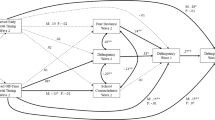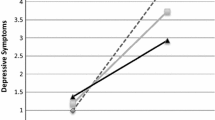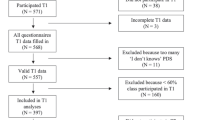Abstract
Most past research on the effects of early pubertal timing on girls’ depressive symptoms and delinquent behavior has focused on either age of menarche or has combined multiple indicators of development into a single index of puberty. Past research has rarely examined both the onset of puberty such as age of menarche, as well more psychologically mediated impressions of puberty (i.e., perceived pubertal timing) within the same study. This study extends past research on racial differences and pubertal related effects on girls’ depressive symptoms and delinquent behavior by examining the independent influence of different indicators of puberty (age of menarche, development of breasts, and perceived pubertal timing). Two waves of data (100 % females) were used from African Americans (N = 481) and European Americans (N = 1259) who were enrolled in seventh- and eighth-grade during the first wave of data collection in the National Longitudinal Study of Adolescent Health. Early age of menarche was associated with high levels of depressive symptoms at Wave 1. Additionally, both early and late perceived pubertal timing were associated with high levels of depressive symptoms and high delinquent behaviors at Wave 1. The structural relationships among these variables were similar for African Americans and European Americans. Age of menarche and perceived pubertal timing influenced depressive symptoms and delinquent behavior at Wave 2 through depressive symptoms and delinquent behavior reported at Wave 1. The implications of these findings are discussed with an emphasis on how the specific indicator used to assess puberty is important in efforts to understand pubertal timing effects.


Similar content being viewed by others
References
Bandura, A. (1982). Self efficacy mechanism in human agency. American Psychologist, 37, 122–147.
Bearman, P. S., Jones, J., & Udry, J. R. (1997). The national longitudinal study of adolescent health: Research design (WWW document). URL: http://www.cpc.unc.edu/projects/addhealth/design.html.
Beaver, K. M., & Wright, J. P. (2005). Biosocial development and delinquent involvement. Youth Violence and Juvenile Justice, 3, 168–192.
Bollen, A. K., & Long, S. J. (1993). Testing structural equation models. Newsbury Park: Sage.
Byrne, B. (2001). Structural equation modeling with AMOS: Basic concepts, applications, and programming. Mahwah, NJ: Lawrence Erlbaum Associates.
Carter, R., Caldwell, C. H., Matusko, N., Antonucci, T., & Jackson, J. S. (2011). Ethnicity, perceived pubertal development, externalizing behaviors and depressive symptoms among Black adolescent girls. Journal of Youth and Adolescence, 10, 1394–1406. doi:10.1007/s10964-010-9611-9.
Carter, R., Jaccard, J., Silverman, W. K., & Pina, A. A. (2009). Pubertal timing and its link to behavioral and emotional problems among African American adolescent girls. Journal of Adolescence, 32, 467–481. doi:10.1016/j.adolescence.2008.07.005.
Caspi, A., & Moffitt, T. E. (1991). Individual differences as accentuated during periods of social changes: The sample case of girls at puberty. Journal of Personality and Social Psychology, 61, 157–168.
Cavanagh, S. E. (2004). The sexual debut of girls in early adolescence: The intersection of race, pubertal timing, and friendship group characteristics. Journal of Research on Adolescence, 14, 285–312.
Craske, M. G. (2003). The origins of phobias and anxiety disorders: Why more women than men. Oxford, England: Elsevier Science.
DeRose, L. M., Shiyko, M. P., Foster, H., & Brooks-Gunn, J. (2011). Associations between menarcheal timing and behavioral developmental trajectories for girls from age 6 to age 15. Journal of Youth and Adolescence, 40, 1329–1342. doi:10.1007/s10964-010-9625-3.
Dorn, L. D., Susman, E. J., & Ponirakis, A. (2003). Pubertal timing and adolescent adjustment and behavior: Conclusions vary by rater. Journal of Youth and Adolescence, 32, 157–167. doi:10.1023/A:1022590818839.
Dubas, J. S., Graber, J. A., & Petersen, A. C. (1991). A longitudinal investigation of adolescents’ changing perceptions of pubertal timing. Developmental Psychology, 27, 580–586.
Faulstich, M. E., Carey, M. P., Ruggiero, L., Enyart, P., & Gresham, F. (1986). Assessment of depression in childhood and adolescnc e: An evaluation of the Center for Epidemiological Studies Deperssion Scale for children (CES-DC). American Journal of Psychiatry, 143, 1024–1027.
Felson, R. B., & Haynie, D. L. (2002). Pubertal development, social factors, and delinquency among adolescent boys. Criminology, 40, 967–988.
Garrison, C. Z., Laddy, C. L., Jaxckson, K. L., McKeown, R. E., & Waller, J. L. (1991). The CES-DC as a screen for depression and other psychiatric disorders in adolescents. Journal of the American Academy of Child and Adolescent Psychiatry, 4, 636–641.
Ge, X., Brody, G. H., Conger, R. D., & Simons, R. L. (2006). Pubertal maturation and African American children’s internalizing and externalizing symptoms. Journal of Youth and Adolescence, 35, 531–540.
Ge, X., Conger, R. D., & Elder, G. H. (1996). Coming of age too early: Pubertal influences on girls’ vulnerability to psychological distress. Child Development, 67, 3386–3400. doi:10.1111/j.1467-8624.1996.tb01919.x.
Ge, X., Conger, R. D., & Elder, G. H. (2001). Pubertal transition, stressful life events, and the emergence of gender differences in adolescent depressive symptoms. Developmental Psychology, 37, 404–417.
Ge, X., Conger, R. D., Lorenz, F. O., Shanahan, M., & Simons, R. L. (1995). Mutual influences in parent and adolescent psychological distress. Developmental Psychology, 31, 406–419.
Graber, J. A., Lewinsohn, P. M., Seeley, J. R., & Brooks-Gunn, J. (1997). Is psychopathology associated with the timing of pubertal development? Journal of the American Academy of Child and Adolescent Psychiatry, 36, 1768–1776. doi:10.1097/00004583-199712000-00026.
Haynie, D. L. (2003). Context’s of risk? Explaining the link between girls’ pubertal development and their delinquent involvement. Social Forces, 82, 355–397.
Hayward, C. (2003). Methodological concerns in puberty-related research. In C. Hayward (Ed.), Gender differences at puberty (pp. 1–14). New York: Cambridge University Press.
Hayward, C., Gotlib, I. H., Schraedley, P. K., & Litt, I. F. (1999). Ethnic differences in the association between pubertal status and symptoms of depression in adolescent girls. Journal of Adolescent Health, 25, 143–149.
Herman-Giddings, M. E., Slora, E. J., Wasserman, R. C., Bourdony, C. J., Bhapkar, M. V., Koch, G. G., et al. (1997). Secondary sexual characteristics and menses in young girls seen in an office practice: A study from the Pediatric Research in Office Settings network. Pediatrics, 99, 505–512.
Huber, P. J. (1967). The behavior of maximum likelihood estimation under nonstandard conditions. In LeCam, L. M. & Neyman, J. (Eds), Proceedings of the Fifth Berkeley Symposium on Mathematical Statistics and Probability, 1. University of California Press, pp. 221–233.
Jaccard, J., Wan, C., & Turrisi, R. (1990). The detection and interpretation of interaction effects between continuous variables in multiple regression. Multivariate Behavioral Research, 25, 467–478. doi:10.1207/s15327906mbr2504_4.
Joyner, K., & Udry, J. R. (2000). You don’t bring me anything but down: Adolescent romance and depression. Journal of Health and Social Behavior, 41, 369–391.
Michael, A., & Eccles, J. C. (2003). When coming of age means coming undone: Links between puberty and psychosocial adjustment among European American and African American girls. In C. Hayward (Ed.), Gender differences at puberty (pp. 277–303). New York: Cambridge University Press.
Morris, N. M., & Udry, J. R. (1980). Validation of a self-administered instrument to assess stage of pubertal development. Journal of Youth and Adolescents, 9, 271–280. doi:10.1007/BF02088471.
Muthen, L. K., & Muthen, B. O. (1998–2007). Mplus user’s guide. Los Angeles: Muthen & Muthen.
Natsuaki, M. N., Biehl, M. C., & Ge, X. (2009). Trajectories of depressed mood from early adolescence to young adulthood: The effects of pubertal timing and adolescent dating. Journal of Research on Adolescence, 19, 47–74. doi:10.1111/j.1532-7795.2009.00581.x.
Negriff, S., & Susman, E. J. (2011). Pubertal timing, depression, and externalizing problems: A framework, review, and examination of gender differences. Journal of Research on Adolescence, 21, 717–746. doi:10.1111/j.1532-7795.2010.00708.x.
Parker, S., Nichter, M., Vuckovic, N., Sims, C., & Ritenbaugh, C. (1995). Body-image and weight concerns about African American and white adolescent females-differences that make a difference. Human Organization, 54, 103–114.
Peskin, H., & Livson, N. (1972). Pre-and post-pubertal personality and adult psychological functioning. Seminars in Psychiatry, 4, 343–353.
Petersen, A. C., Sarigiani, P. A., & Kennedy, R. E. (1991). Adolescent depression: Why more girls? Journal of Youth and Adolescence, 20, 247–271.
Petersen, A. C., & Taylor, B. (1980). The biological approach to adolescence: Biological change and psychological adaptation. In J. Adelson (Ed.), Handbook of adolescent psychology. New York: Wiley.
Polivy, J., & Herman, C. P. (2003). Causes of eating disorders. Annual Review of Psychology, 53, 187–213. doi:10.1146/annurev.psych.53.100901.135103.
Radloff, L. S. (1977). The CES-D Scale: A self-report depression scale for research in the general population. Applied Psychological Measurement, 1, 385–401.
Radloff, L. S. (1991). The use of the Center for Epidemiologic Studies Depression Scale in adolescent and young adults. Journal of Youth and Adolescents, 20, 149–166.
Roberts, R. E., Andrews, J. A., Lewinsohn, P. M., & Hops, H. (1990). Assessment of depression in adolescents using the Center for Epidemiologic Studies Depression Scale. Psychological Assessment, 2, 122–1285. doi:10.1037/1040-3590.2.2.122.
Ruble, D. N., & Brooks-Gunn, J. (1982). The experience of menarche. Child Development, 53, 1557–1566.
Sanborn, K., & Hayward, C. (2003). Hormonal changes at puberty and the emergence of gender differences in internalizing disorders. In C. Hayward (Ed.), Gender differences at puberty (pp. 29–58). New York, NY: Cambridge University Press.
Satorra, A., & Bentler, P. (1999). A scaled difference Chi square test statistic for moment structure analysis. Technical Report University of California, Los Angeles. http://preprints.stat.ucla.edu/260/chisquare.pdf.
Snyder, M. (1983). The influence of individuals on situations: Implications for understanding the links between personality and social behavior. Journal of Personality, 51, 497–516.
Striegel-Moore, R. H., McMahon, R. P., Biro, F. M., Schreiber, G., Crawford, P. B., & Voorhees, C. (2001). Exploring the relationship between timing of menarche and eating disorders symptoms in black and white adolescent girls. International Journal of Eating Disorders, 30, 421–433. doi:10.1002/eat.1103.
Susman, E. J., Dorn, L. D., & Chrousos, G. P. (1991). Negative affect and hormone levels in young adolescents: Concurrent and predictive perspectives. Journal of Youth and Adolescence, 20, 167–190.
Tanner, J. M. (1972). Sequence, tempo, and individual variation in growth and development of boys and girls aged 12 to 16. In J. Kagan & R. Coles (Eds.), Twelve to sixteen: Early adolescence (p. 1e23). New York: Norton.
Thompson, J. K., & Stice, E. (2001). Thin-ideal internalization: Mounting evidence for a new risk factor for body-image disturbance and eating pathology. Current Directions in Psychological Science, 10, 181–183. doi:10.1111/1467-8721.00144.
Tourangeau, R., & Shin, H. C. (1998). The National Longitudinal Study of Adolescent Health: Grand sample weights. Chapel Hill, NC: Carolina Population Center, University of North Carolina at Chapel Hill.
Udry, J. R. (1997). A research design for studying romantic partners. In J. Bancroft (Ed.), Researching sexual behavior: Methodological issues (pp. 237–250). Bloomington: University Press.
Udry, J. R., Talbert, L. M., & Morris, N. M. (1986). Biosocial foundations of adolescent female sexuality. Demography, 23, 217–230.
Wangby, M., Bergman, L. R., & Magnusson, D. (1999). Development of adjustment problems in girls: What syndromes emerge? Child Development, 70, 678–699.
Weissman, M. M., Orvaschel, H., & Padian, N. (1980). Children’s symptom and social functioning self-report scales: Comparison of mothers’ and children’s reports. Journal of Nervous Mental Disorders, 168, 736–740.
White, H. (1982). Maximum likelihood estimation of misspecified models. Econometrica, 50, 1–25.
Wu, T., Mendola, P., & Buck, G. M. (2002). Ethnic differences in the presence of secondary sex characteristics and menarche among US girls: The Third National Health and Nutrition Examination Survey, 1988–1994. Pediatrics, 110, 752–757. doi:10.1542/peds.110.4.752.
Acknowledgments
This research used data from the National Longitudinal Study of Adolescent Health (Add Health), a project designed by J. Richard Udry, Peter S. Bearman, and Kathleen Mullan Harris, and funded by Grant P01-HD31921 from the NICHD, with cooperative funding from 17 other agencies. Special acknowledgment is owed to Ronald R. Rindfuss and Barbara Entwisle for assistance in the original design. To obtain data files from Add Health, contact Add Health, Carolina Population Center, 123 West Franklin Street, Chapel Hill, NC 27516-2524 (www.cpc.unc.edu/addhealth/contact.html).
Author contributions
R.C. conceived of the study, participated in its design and coordination, performed the statistical analysis; and drafted the manuscript; W.K.S helped to draft the manuscript and participated in its design and coordination; J.J. participated in its design, helped to perform the statistical analysis, and interpretation of the data. All authors read and approved the final manuscript.
Author information
Authors and Affiliations
Corresponding author
Rights and permissions
About this article
Cite this article
Carter, R., Silverman, W.K. & Jaccard, J. Race and Perceived Pubertal Transition Effects on Girls’ Depressive Symptoms and Delinquent Behaviors. J Youth Adolescence 42, 1155–1168 (2013). https://doi.org/10.1007/s10964-012-9885-1
Received:
Accepted:
Published:
Issue Date:
DOI: https://doi.org/10.1007/s10964-012-9885-1




